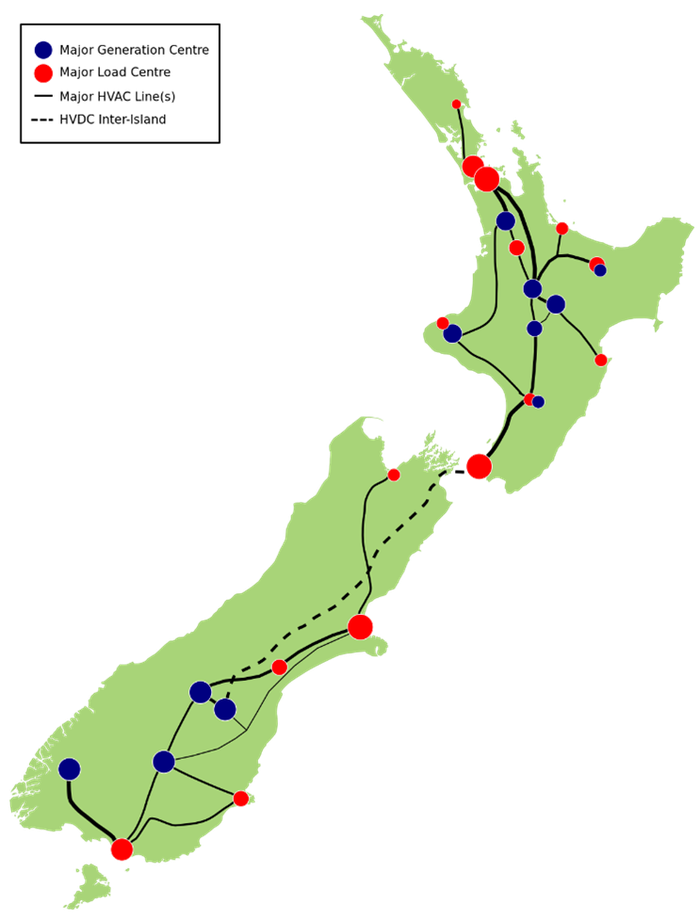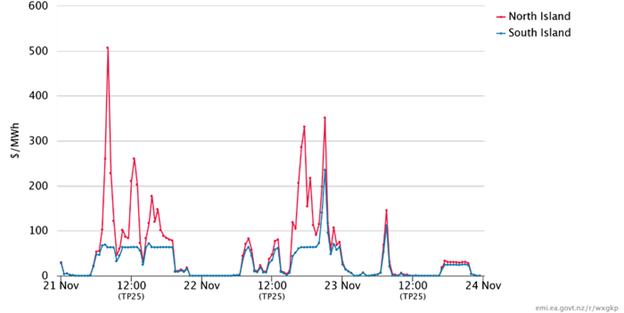Eye on electricity
Geography, locational pricing and price separation
- Distribution
- Wholesale
The wholesale electricity market is where retailers purchase electricity from generators at half-hourly spot prices. In New Zealand, pricing in this market at each grid exit point reflects the cost of transporting electricity to that location. Therefore, the spot price at each location will be different and is known as locational marginal pricing.
Several factors contribute to the variance in spot prices across the country, including:
- the distance from generation
- the capacity of transmission lines
- the flow of electricity through the high voltage direct current cables (HVDC)
- the need for reserves and generation outages.
This article explains these factors and the economic benefit behind locational pricing in the electricity market.
Electricity ‘transport costs’ are included in locational prices
Electricity in New Zealand is transported, using the national grid, from power stations to households, businesses and large industrial users. Different types of electricity generation occur in different places, often reflecting the location of natural resources like rivers and geothermal reservoirs.
The largest hydro power stations are in the South Island, near large lakes. The North Island contains all of New Zealand’s thermal and geothermal power stations, and most of our wind farms.
There will always be small differences in prices between locations because of heat losses on the lines that transport electricity. This is typically around 3% of the total electricity transported and this cost is included in the price at each location.
Transmission constraints can also impact each location’s price. These occur when a line transporting electricity reaches its maximum capacity. This can be exacerbated by outages of other lines to the same location – both planned and unplanned. This congestion on the grid can add costs to transporting electricity to a particular location, which are included in the locational prices.
Price differences across the two main islands
The HVDC lines electrically link the North and South islands, see Figure 1. Since hydro generation accounts for a large portion of our total electricity generation (over 50%), these large cables mostly transport electricity produced in the South Island up to cities in the North Island where there is higher demand.

New Zealand’s geography can sometimes mean that the difference between North and South island’s spot prices is large. This is called price separation and is the result of transmission constraints (rather than losses). Over the last five years, a price differential of more than $20 between the Ōtāhuhu and Benmore nodes existed around 30% of the time.
If significant price separation occurs, there are usually lower prices in the South Island and higher prices in the North. This type of price separation occurred in November 2022, as seen in Figure 2.

Heavy rain refilled many South Island hydro lakes allowing southern hydro generators to offer high outputs at a low offer price. It was therefore cheapest to generate a lot of electricity in the South and transport it North.
This meant the HVDC was running hard – often up to the limit of what it can transfer (especially since wind was low at that time in the North Island). Once this limit is reached, extra electricity for North Island demand is met using North Island generation. North Island prices will therefore be set by more expensive North Island generation, while South Island prices will still be set by the lower priced South Island generation.
What impacts spot price separation
The electricity system must have generation on stand-by to provide backup electricity supply in the event that a generator stops running or a transmission line stops working. Hence, enough reserve or ‘spare’ generation capacity is kept available to meet the loss of the largest part of the system that could fail. This ‘risk setting unit’ is usually either the largest generation unit that is running or the HVDC. Sometimes the cost of this reserve can cause prices to separate between islands. Read more about reserves in this Eye on electricity article.
North Island thermal and geothermal power station outages also contributed to price separation during November 2022. During this time the largest and most efficient Huntly thermal unit, Huntly 5, was on outage with electricity demand instead being met by other more expensive thermal units.
Locational pricing encourages smart investment in new generation
Locational pricing reflects the costs of getting generation to different locations. These price differences allow investors to see opportunities associated with different locations, both in terms of electricity generation and consumption. For example, an area with little spare transmission capacity would experience price separation often. This could present an opportunity for someone to build generation behind the constrained transmission line and supply demand in that area.
The Authority’s generation investment dashboard shows that, of projects with known locations, 75% of planned capacity is in the North Island, with more in Waikato than any other region to cater for the major load areas of Auckland and Hamilton.
Related News
Clarification on small business eligibility for peak export rebates
In July 2025 we introduced a requirement that, from 1 April 2026, electricity distribution businesses will need to pay negative charges (rebates) to households…
Update on our distributor guidance to support a competitive flexibility services market
We’re finalising our ‘Guidance for distributors involved in the flexibility services market’, which is expected to be published in early 2026.
Code finalised to make connecting to networks faster and easier
We have finalised the Code giving effect to new requirements that improve the application processes for connecting to networks.